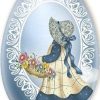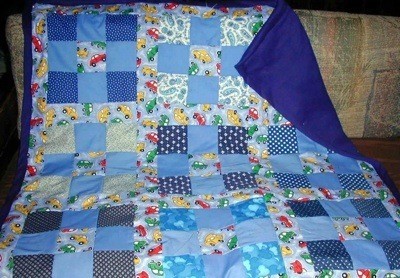Christmas will be here before we know it. Time to decide on handmade gifts for those you love. This is a basic simple quilt that is lightweight and very warm. You'll get lots of compliments on your handmade personal gift.
Approximate Time: 2-3 days
Supplies:
- 42 4X4 inch squares of solid material
- 42 4 inch squares of printed material
- paper and pencil -optional
- sewing machine or needle and thread
- iron
- 1-2 inch border material
- pins
- measuring tape
- backing material
- thermo lining or quilted mattress cover (bigger than quilt size)
- needle and yarn or embroidery floss.
Instructions:
First you must choose your colors. I would suggest you use solid fabrics as well as printed ones. You can mix and match solid colored squares if you wish. This will give it a rainbow effect and usable in almost any decor.
- You will need to begin by choosing a size for your squares. 4X4 squares are easy to work with so that is what I will be using in this tutorial. Remember all the instructions here are made for the 4X4 squares so if you plan a different sized square you will need to make adjustments.
- You will need to either cut your squares from fabric or buy them online. You may either hand sew the pieces or machine stitch them using a simple straight line. I'll give you some time to decide which you wish to do. The finished product should be under 42 inches X 42 inches due to the 1/4 inch seam allowances. For this project you will need 42 - 4 inch solid colors and 42 - 4 inch colored prints.>/li>
- I always draw out my plan on paper first. Put six rows across and 12 rows down. Then in each block put an "S" for solid or a "P" for print. There you have your diagram.
- First line your squares up one solid, one print until you have six all together and you'll end up with a solid. (If you do a print first it will be opposite what I just said.) Lay them in order upside down and sew the first set together using a 1/4 inch seam on the backside of the material. One solid, then one print, until you have all 6 finished.
- Lay this across a chair or somewhere out of reach and begin your next row. Continue until you have all 12 rows.
- So, you have 12 rows of "patches," iron all your rows before you begin anything else.
- Pin the fist row at the bottom to the second row's top and stitch it together. Then keep pinning and stitching until you have all 12 rows sewn together.
- You have to iron all the quilt now and if you'd like to add a border choose a piece of material that offsets your pattern. It can be a pattern or just plain. Measure all sides then start with one of the longer sides and pin it on and sew 1/4 inch stitch all the way to the top. I always have extra fabric at the ends for those just in case, so when you measure add a few inches. Do both long sides first then do the top and bottom. You will be trimming off the excess parts.
- For those who have never added a border. Measure your length and width. Start with your length and cut a strip 2-3 inches the size you need for each side (I always add a few inches in case I am not on target and it will need to be longer on both ends.
- Start by putting on the sides first (longest part), then sew the width on top of that. It is easier than the other way around and much neater. You can sew over extra pieces and trim later on.
- If you wish to add a second border do so now following the first border instructions. Make sure your fabric compliments each other.
- Now you need to choose something to go in the middle for a lining. I like to use quilted mattress covers. This way I know it won't come apart. It is also light weight and warm. I have found people like lightweight best. You can get these at thrift stores or use one that is not usable on a bed anymore. (You may also buy thermo lining at your local department store, but it is expensive.) Measure your quilt top and cut it just a little bit bigger than the measurements. Figure out what you'd like to back it with that will offset your fabric squares. This can be a print or solid, your choice. Measure your top adding at least 2 inches extra for the sides and the top and bottom. I like more than 2 inches in case I mess it up. For a bigger quilt you may have to run a seam down the middle of two pieces of the fabric and buy what you need to finish off your backing.
- To finish up your quilt you will need to sandwich all three pieces together with your backing material down first with the design on the bottom and then the old blanket or batting then your finished top face up. You should have this centered so you have a little left all the way around. At this point I go through and tie off parts beginning at the middle and working outward. You can tie it with colored embroidery thread or yarn. If you plan on quilting it you will need to pin it. (If quilting, go ahead and machine quilt now before you move to the next step.)
- Then take one side first and pull it up and turn over the edge twice so you have about one inch to sew a seam. Pin the sides first then ends. I like to miter my ends and make them look nice. Now you are ready to sew it together.
- Sew each side first removing the pins as you go so you don't sew over the pins and break your needle. Sew the top and bottom, when you get to the mitered edges it is a good idea to run a seam across them too so they don't get hung up when sleeping and to ensure safety for little ones and viola you are done!
I have embellished quilts with ribbons instead of yarn. The little rosettes are very pretty also for a baby quilt. You can tie the quilt off and finish it and then go back and add the rosettes by hand stitching them on. This makes for a very feminine quilt.
The picture does not reflect the actual size of this particular quilt, but is added as a reference so that you can see and understand how it turns out.
By gem from VA

